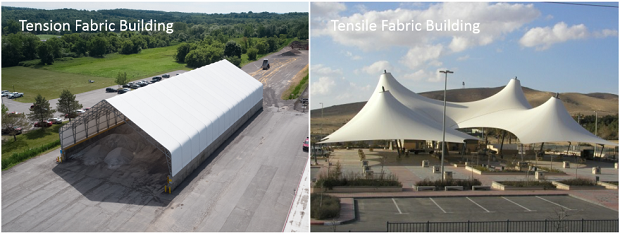Calhoun Super Structure
The Difference Between Tensile Fabric Buildings and Tension Fabric Buildings

Both tensile fabric buildings and tension fabric buildings continue to gain popularity because they are typically more affordable, easier to install, and span large distances without interior poles or pillars. However, the difference between the two is not always clear.
In practice, structures tend to carry both tension and compression, however, it is to the degree of which a structure is intended to stabilize that determines whether it is considered a tensile fabric building or a tension fabric building.
What Are Tensile Fabric Buildings?
Tensile fabric structures are constructed using PTFE-coated fiberglass, ETFE film, or PVC-coated polyester as the membrane materials, along with mild steel cables, stainless steel, or aramid fibers for the structural frame. Tensile fabric structures are commonly known as thin-shell structures that create a dramatic piece of architecture due to their double-curved shape which provides most of the structure’s strength. By forcing the fabric to take on a double curvature, the fabric gains sufficient stiffness to withstand the loads it is subjected to. In tensile fabric structures, the fabric does not crease thanks to the tension in the membrane.
How Are Tensile Fabric Buildings Used?
Tensile fabric structures are often used for lightweight or temporary installations. The lighter weight makes these structures easier to transport, and the flexible materials can create an impressive feature. There are a variety of uses for tensile fabric structures, including:
• Temporary buildings
• Modular frame buildings
• Canopies
• Skywalks
• Sheltered walkways
• Shaded areas
• Atrium roofing
• Showpieces
What Are Tension Fabric Buildings?
Tension fabric buildings are constructed with steel frames and industrial-strength fabric membranes where the fabric membrane is tensioned. In a tension fabric building, the steel framework provides all the structural support rather than the fabric membrane. For example, as a load is imposed on the top chord of the truss of a tension fabric building, the top chord will be in compression and the bottom chord will be in tension. Tension fabric buildings are constructed in modules using overhead cranes, and held in position by tension forces imposed by the structural framework or cabling system.
How Are Tension Fabric Buildings Used?
Tension fabric structures are frequently used to create more permanent storage buildings or indoor recreational facilities. Tension fabric structures can reduce a building’s energy consumption and block UV rays that induce heat. Common uses for tension fabric structures include:
• Warehouses
• Storage buildings
• Agriculture or livestock buildings
• Oil and gas storage structures
• Event structures
• Municipal salt storage
So, What’s the Difference?
Tensile structures typically use less material than tension fabric buildings which result in a much lighter structure. While they can be used to create entire buildings, tensile structures are more common for intricate design work or landscaping features. Tensile fabric structures carry only tension rather than compression. For example, tensile structures are essentially a piece of fabric pulled in opposite directions. The sufficient stiffness that the fabric gains from the double curvature is what withstands the loads that the building is subjected to.
Tension fabric structures tend to be stronger and more durable than tensile fabric structures. These structures are typically engineered and fabricated to meet structural, flame-retardant, weather-resistant, and natural force requirements so to meet strict building codes. The steel framework provides all the structural support in a tension fabric building; the fabric acts as the protective cover, letting in natural light while keeping the elements out.
Should You Choose Tensile or Tension Fabric Buildings?
If your project requires an engineered, built-to-last fabric structure, then a tension fabric structure is your answer. Calhoun’s tension fabric buildings are engineered site-specific using our unique 3D Nonlinear Finite Element Analysis. We model the true behavior of fabric relative to environmental factors producing the most suitable fabric structures to meet your requirements, and the longest-standing structure in the industry. We also use engineered high-density polyethylene (HDPE) fabric manufactured from 12 oz per square yard in weight, and 24 mil thick. Known for its large strength-to-density ratio (which can range from 930 to 970 kg/m3), HDPE provides stronger intermolecular forces and strength than other tension fabric membranes.
Source: https://calhounsuperstructure.com/the-difference-between-tensile-fabric-buildings-and-tension-fabric-buildings/
Careers with Calhoun
At Calhoun Super Structures, we believe that our strength is in our structure. Not just the structure of our fully engineered line of fabric covered buildings, but the structure of our company, our employees and our dealer network.